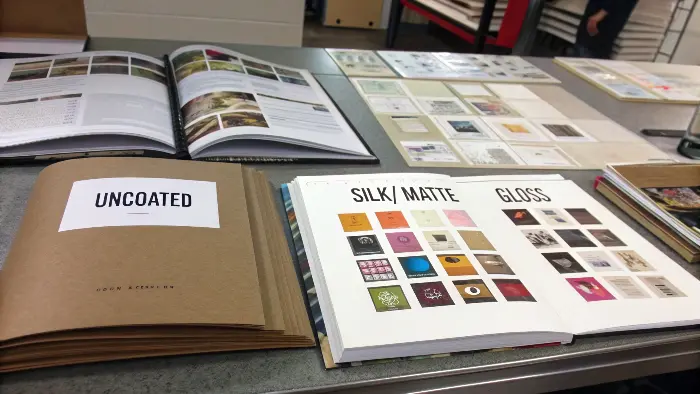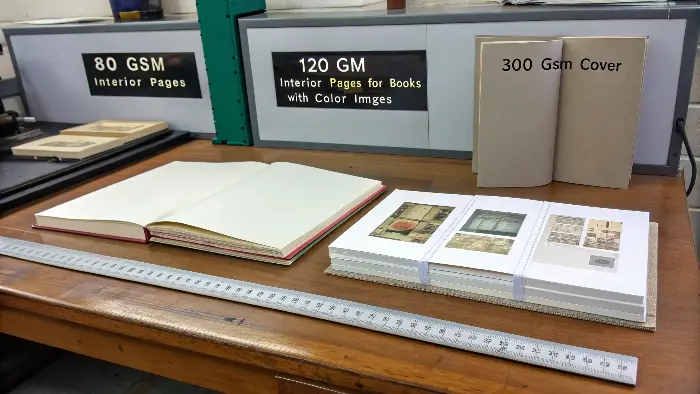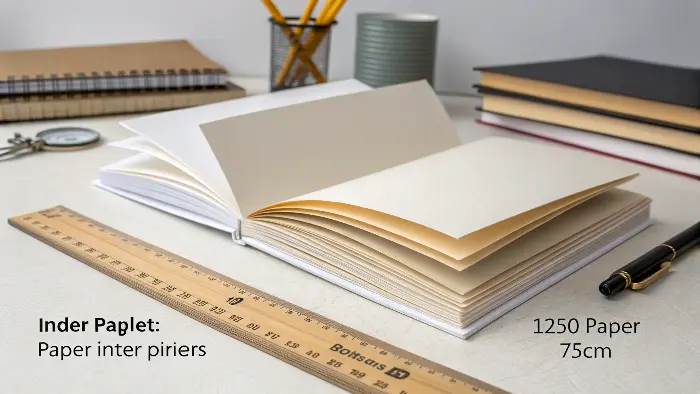Choosing the wrong paper can completely ruin a book project, making it feel cheap or causing ink to bleed through. This leads to wasted money, unhappy customers, and a product that fails to represent your brand’s quality. Understanding paper is key to avoiding these costly mistakes.
The best paper for book production depends entirely on the book’s purpose. For text-heavy books like novels, use an uncoated paper around 80-120 gsm for easy reading. For books rich with images, like art or photo books, a heavier coated paper of 120-170 gsm is better to make colors pop. The cover always needs a much heavier stock, typically 250-350 gsm, for durability and a premium feel.

Choosing the right paper feels like a small detail, but it makes a huge difference in the final product. It affects everything from the reader’s experience to your shipping costs. This decision is one of the most important you’ll make in the production process. But where do you even start? Let’s break down the key factors you need to consider, starting with the most fundamental choice: the type of paper itself.
What Kind of Paper Should You Use When Making a Book?
You have a great book design, but the sheer number of paper options is overwhelming. Coated, uncoated, silk, gloss… what do they all mean? Picking the wrong one can make your text hard to read or your images look dull. It’s a decision that can make or break the entire project. Let’s simplify it. The choice boils down to two main categories.
Use uncoated paper for text-heavy books like novels or journals, as it’s easy on the eyes and great for writing on. For books with many photos or graphics, like art books or catalogs, use coated paper (gloss or silk/matte). Coated paper makes colors pop and images look sharp, providing a more professional, high-quality finish that elevates the perceived value of the product.

The first major decision you’ll make is between coated and uncoated paper stock. This choice influences the look, feel, and suitability of the paper for your specific project. As a supplier, this is the first question we ask clients to help narrow down the options. Each type serves a very different purpose, and understanding this difference is the foundation of good paper selection.
Coated vs. Uncoated: The Core Decision
Coated paper has a sealant, typically made of clay, that fills the paper’s natural pores. This creates a smooth, non-porous surface. Ink sits right on top of this coating instead of soaking in. This results in incredibly sharp details and vibrant, bright colors, which is why it’s the standard for photography and art books. There are two common finishes: gloss, which is very shiny and makes colors pop, and silk/matte, which has a low-glare, smooth finish that feels very premium.
Uncoated paper, on the other hand, has no extra coating. It’s porous and absorbs ink into its fibers. This gives it a more natural, tactile feel. The lack of a reflective coating makes it much easier to read long passages of text without eye strain. This is why it’s the perfect choice for novels, journals, workbooks, and planners—any product where readability or writability is the top priority.
| Feature | Coated Paper | Uncoated Paper |
|---|---|---|
| Best For | Images, Photos, Graphics | Text-heavy content, Writing |
| Finish | Glossy or Matte/Silk | Natural, slightly rough |
| Ink | Sits on the surface | Absorbs into the fibers |
| Readability | Can have glare | Excellent for long text |
| Feel | Smooth, slick | Tactile, organic |
| Common Use | Art Books, Catalogs | Novels, Journals, Workbooks |
What Is the Best Paper Weight for Making a Book?
You’ve chosen the paper type, but now you’re stuck on the weight. Is 80 gsm too thin? Is 150 gsm too thick and expensive? A wrong choice can lead to ink bleeding through the pages if it’s too thin. Or it can create a book that’s too stiff and heavy to handle comfortably if it’s too thick. This is a critical balancing act between quality, usability, and cost.
For a standard novel or trade paperback, 80-120 gsm is ideal for the interior pages. For books with color images, like children’s books or cookbooks, 120-170 gsm works best to prevent ink from showing through. The cover should be much heavier, typically 250-350 gsm, to provide the necessary durability and a high-quality, substantial feel in the hand.

Paper weight is measured in Grams per Square Meter (gsm). A higher gsm number means a heavier, thicker, and often more opaque paper. The right weight depends on the book’s content and its intended quality perception. I’ve seen many projects where the paper weight was the deciding factor between a professional product and an amateur one. It’s not just about thickness; it’s about matching the weight to the book’s function.
Understanding GSM for Book Pages and Covers
For the interior pages, or the "text block," the choice of gsm is crucial for the reading experience. A standard novel doesn’t need thick paper, so 80-100 gsm is common. It’s cost-effective and lightweight. For a higher quality trade paperback or a business book, stepping up to 100-120 gsm provides better opacity (less show-through) and a more substantial feel. When a book contains many full-color images, like a cookbook or art book, you need at least 120-170 gsm. This weight prevents images on the other side of the page from being visible and gives the colors a solid base.
The cover is a different story. It needs to be durable enough to protect the pages and provide structural integrity. For a softcover or paperback book, a weight between 250-350 gsm is standard. A 250 gsm cover is flexible yet sturdy, while a 350 gsm cover feels very rigid and premium. The choice often comes down to the desired market position of the book.
| Paper Weight (GSM) | Common Use | Feel & Characteristics |
|---|---|---|
| 80-100 gsm | Novels, Mass-market Paperbacks | Lightweight, cost-effective, some show-through. |
| 100-120 gsm | Trade Paperbacks, Journals | Good quality feel, better opacity, standard choice. |
| 120-170 gsm | Art Books, Photo Books, Cookbooks | Thicker, premium, excellent for images, minimal show-through. |
| 250-350 gsm | Paperback Covers | Stiff, durable, provides structure and protection. |
What Is the Best Paper Weight for Booklets?
Booklets seem simpler than books, but choosing the paper is just as tricky. You want it to feel professional, not like a flimsy flyer that gets tossed away. If the paper is too thin, the booklet looks cheap and won’t last. If it’s too thick, it won’t fold neatly at the spine or stay open easily. The key is finding the right balance for both the cover and the interior pages.
For booklet interior pages, 120-150 gsm is a great all-around choice. It feels substantial enough to be high-quality but is still thin enough to fold well in a saddle-stitched binding. For the cover, use a slightly heavier stock like 170-250 gsm. This creates a noticeable difference and adds durability without making the booklet too rigid to use.

Booklets, which are typically saddle-stitched (stapled at the spine), have different physical requirements than perfect-bound books. The paper needs to be flexible enough to fold cleanly without cracking, especially at the spine. The page count also plays a significant role. A booklet with many pages made from very thick paper can suffer from "creep," where the inner pages stick out further than the outer ones when folded.
Balancing Durability and Flexibility in Booklets
For most marketing or informational booklets, a coated silk or matte paper is the preferred choice because it handles both text and images well. A weight of 120-150 gsm for the interior pages hits the sweet spot. It has excellent opacity, feels professional, and avoids the flimsy feel of standard office paper. If a booklet has a very high page count (e.g., over 48 pages), we sometimes advise clients to drop the interior weight to 100 gsm to reduce bulk and prevent creep.
For the cover, you have two main options. You can use a "self-cover," where the cover is the same paper stock as the interior pages. This is a cost-effective and modern choice, and a 150 gsm or 170 gsm stock works well for this. Alternatively, using a separate, heavier cover stock gives the booklet a more traditional and durable feel. A 200-250 gsm cover provides a clear distinction and protects the inner pages more effectively.
| Booklet Component | Recommended Weight (GSM) | Why It Works |
|---|---|---|
| Interior Pages | 120-150 gsm | Feels professional, good opacity, folds well. |
| Separate Cover | 170-250 gsm | Adds durability and a premium feel. |
| Self-Cover | 150-170 gsm | Cost-effective, consistent look, good for thinner booklets. |
| High Page Count | Consider 100-120 gsm (Interior) | Reduces bulk and prevents page "creep". |
Which Paper Size Is Best for Book Printing?
You’ve sorted the paper type and weight, but now you need to pick a size. The options seem endless, from A5 to custom dimensions. Choosing a non-standard size can dramatically increase your printing costs and limit your distribution options. It’s a costly mistake to make because it leads to significant paper waste during production. Sticking to industry-standard sizes is almost always the smartest move.
The best paper size depends on your book’s genre and target market. For novels and trade paperbacks, common sizes are 5.5" x 8.5" (digest) in the US and A5 (148 x 210 mm) in Europe. For larger non-fiction or art books, US Letter (8.5" x 11") or A4 (210 x 297 mm) are standard. Sticking to these sizes is more cost-effective and efficient.

Printers work with large parent sheets of paper. Standard book sizes are designed to be cut from these parent sheets with minimal waste. When you request a custom size, it often results in more paper being trimmed off and discarded, and you pay for that waste. For my clients like Michael in Germany, who are developing product lines for retail, using a standard size like A5 is crucial for cost control and market acceptance.
Common Book Sizes for Global Markets
While we can produce any custom size, we always advise our clients to consider the economic and practical benefits of standard dimensions. In the United States, the most popular paperback size for fiction and non-fiction is 5.5" x 8.5", often called "digest" size. A slightly larger 6" x 9" ("US Trade") is also very common. For larger format books like workbooks or manuals, 8.5" x 11" ("US Letter") is the go-to.
In Europe and most other parts of the world that use the ISO paper system, A-series sizes are standard. The A5 size (148 x 210 mm) is the direct equivalent of the US digest size and is perfect for novels and journals. The A4 size (210 x 297 mm) is the standard for business reports, educational materials, and large-format books. Choosing the right standard size for your target market ensures your book feels familiar to consumers and keeps your production costs in check.
| Book Size | Dimensions | Common Genre/Use | Market |
|---|---|---|---|
| Digest | 5.5" x 8.5" | Novels, Trade Paperbacks | US |
| US Trade | 6" x 9" | Fiction, Non-Fiction | US |
| A5 | 148 x 210 mm | Novels, Journals | Europe/International |
| US Letter | 8.5" x 11" | Workbooks, Manuals, Art Books | US |
| A4 | 210 x 297 mm | Reports, Educational Books | Europe/International |
Conclusion
Choosing the right paper type, weight, and size is crucial for a successful book project. These decisions directly impact the final look, feel, and cost. By understanding the basics of coated vs. uncoated, gsm, and standard dimensions, you can create a product that perfectly matches your brand’s quality.

